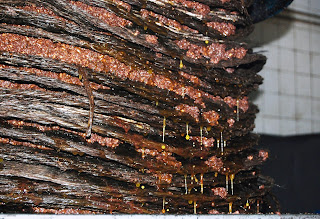Olive
oil against Alzheimer’s Disease.
Alzheimer's
disease affects about 30 million people worldwide, but the prevalence is lower
in Mediterranean countries. Scientists once attributed it to the high
concentration of healthful monounsaturated fats in olive oil, consumed in large
amounts in the Mediterranean diet. Newer research suggested that the actual
protective agent might be a substance called oleocanthal, which has effects
that protect nerve cells from the kind of damage that occurs in this disease.
 |
Oleocanthal, a phenolic component of extra-virgin
olive oil, has been recently linked to reduced risk of Alzheimer’s disease, a
neurodegenerative disease that is characterized by accumulation of β-amyloid and tau
proteins in the brain. However, the mechanism by which oleocanthal exerts its
neuroprotective effect is still incompletely understood.
This study provides in vitro and in vivo evidence for the potential of oleocanthal to enhance β-amyloid clearance from the brain via up-regulation of P-glycoprotein (P-gp) and LDL lipoprotein receptor related protein-1 (LRP1), major β-amyloid transport proteins, at the blood-brain barrier (BBB).
This study provides in vitro and in vivo evidence for the potential of oleocanthal to enhance β-amyloid clearance from the brain via up-regulation of P-glycoprotein (P-gp) and LDL lipoprotein receptor related protein-1 (LRP1), major β-amyloid transport proteins, at the blood-brain barrier (BBB).
Results from in vitro and in vivo studies demonstrated similar and consistent pattern of oleocanthal in controlling β-amyloid levels. In cultured mice brain endothelial cells, oleocanthal treatment increased P-gp and LRP1 expression and activity. Brain efflux index (BEI%) studies of 125I-Aβ40 showed that administration of oleocanthal extracted from extra-virgin olive oil to C57BL/6 wild-type mice enhanced 125I-Aβ40 clearance from the brain and increased the BEI% from 62.0 ± 3.0% for control mice to 79.9 ± 1.6% for oleocanthal treated mice. Increased P-gp and LRP1 expression in the brain microvessels and inhibition studies confirmed the role of up-regulation of these proteins in enhancing 125I-Aβ40 clearance after oleocanthal treatment. Furthermore, our results demonstrated significant increase in 125I-Aβ40 degradation as a result of the up-regulation of Aβ degrading enzymes following oleocanthal treatment.
In conclusion, these findings provide experimental support that potential reduced risk of Alzheimer's disease associated with extra-virgin olive oil could be mediated by enhancement of β-amyloid clearance from the brain.







